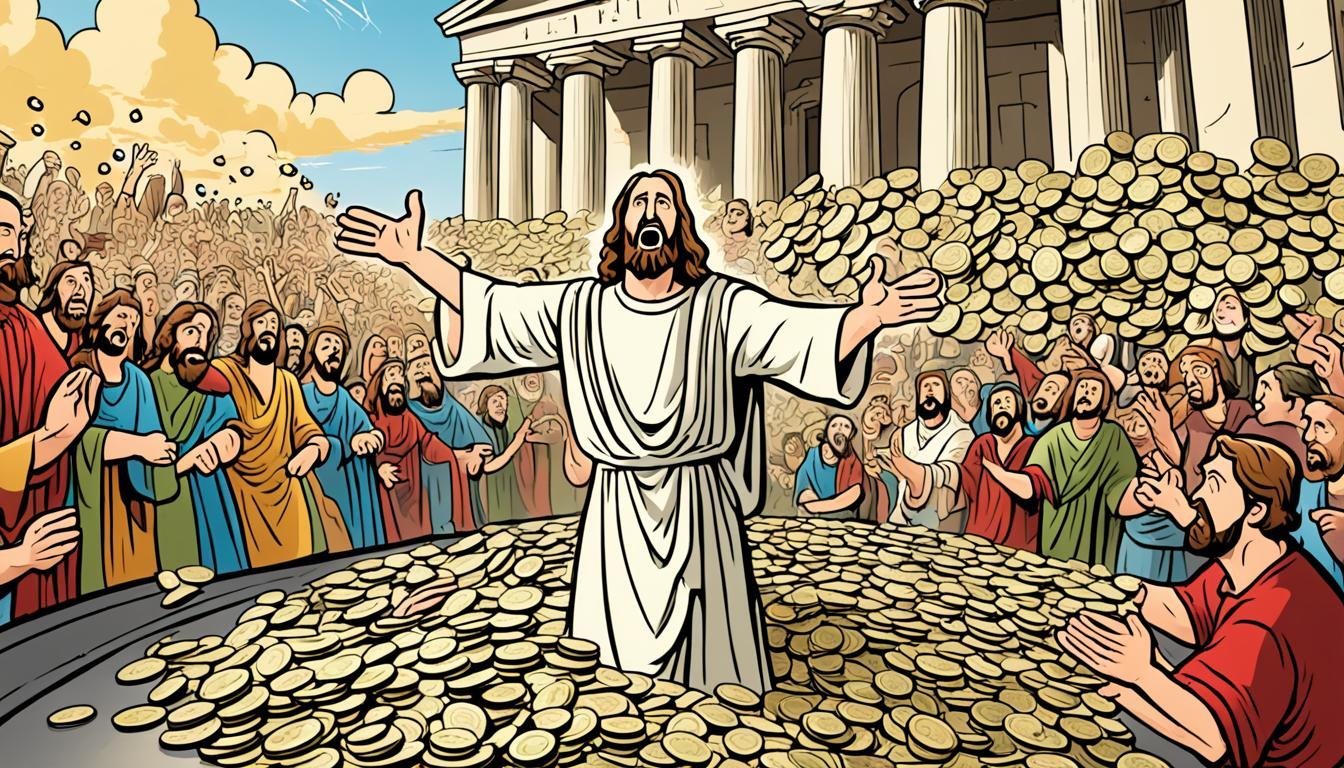In Christian history, the biblical moment of Jesus cleansing the temple holds great significance. This powerful act is recorded in the second chapter of John as well as in the Synoptic Gospels (Matthew, Mark, and Luke). However, there is some debate as to whether these accounts describe the same event or separate incidents. Nevertheless, one thing is clear – Jesus’ actions in cleansing the temple left a lasting impact on the history of Christianity.
Key Takeaways:
- Jesus cleansed the temple at least twice, once near the beginning of His ministry and again just prior to His death.
- The accounts of the cleansing of the temple can be found in the second chapter of John and in the Synoptic Gospels.
- There are differences between the temple cleansing accounts, but the messages conveyed by Jesus were similar.
- The temple cleansing events highlight the importance of obedience to God and true worship.
- Jesus’ actions challenged the religious leaders‘ hypocrisy and emphasized the need for genuine worship over empty rituals.
The “Problem” of the Temple Cleansing Accounts
One of the intriguing aspects of the cleansing of the temple is the apparent contradiction between the accounts given in the Gospel of John and the Synoptic Gospels (Matthew, Mark, and Luke). In John’s Gospel, the cleansing of the temple is described as occurring during the first Passover mentioned, whereas the Synoptic Gospels place it just days before Jesus’ Crucifixion. This contradiction has led to discussions and debates among Christians.
Some individuals believe that these accounts describe the same event, viewing the differences in timing as a matter of perspective or emphasis. Others, however, see them as separate incidents, believing that Jesus cleansed the temple on multiple occasions. So, what is the right account?
The solution lies in recognizing that Jesus indeed cleansed the temple on at least two occasions. The biblical accounts provide support for this conclusion, and it is essential to give the biblical authors the benefit of the doubt. The narratives serve different purposes and highlight various aspects of Jesus’ ministry and the significance of temple cleansing in both instances.
To understand the cleansing of the temple fully, it is necessary to examine these accounts in their historical and theological contexts. By doing so, we can gain a more profound appreciation for the cleansing of the temple as a pivotal moment in Jesus’ life and ministry.
Differences Between the Temple Cleansing Accounts
When comparing the temple cleansing accounts, there are notable differences in the details provided by the Gospel of John and the Synoptic Gospels (Matthew, Mark, and Luke). These variations offer unique perspectives on the event, shedding light on different aspects of the confrontation between Jesus and the temple officials.
“And the Jews’ passover was at hand, and Jesus went up to Jerusalem. And found in the temple those that sold oxen and sheep and doves, and the changers of money sitting: And when he had made a scourge of small cords, he drove them all out of the temple, and the sheep, and the oxen; and poured out the changers’ money, and overthrew the tables…” – John 2:13-15
In the Gospel of John, the account of the temple cleansing emphasizes the immediate confrontation between Jesus and the temple officials. Jesus encounters those selling animals for sacrificial purposes and those exchanging money. He takes decisive action by making a whip of cords and driving out both the animals and the merchants. This passage also includes Jesus’ prophecy of His future Resurrection, adding a deeper layer of meaning to the event.
However, in the Synoptic Gospels, the focus shifts slightly. After the second cleansing, Jesus begins to teach and heal in the temple, which highlights His mission of spreading the message of God’s Kingdom and providing hope and healing to the people.
Another notable difference is the mention of Jesus making a whip of cords in John’s account, while the Synoptic Gospels do not mention this detail. The presence of the whip of cords signifies Jesus’ urgency and determination in confronting the corrupt practices within the temple.
Despite these differences, the underlying messages conveyed in both accounts remain consistent. Both highlight Jesus’ authority and zeal in challenging the exploitation and hypocrisy within the temple, emphasizing the importance of true worship and obedience to God.
Summary of Differences
| Gospel of John | Synoptic Gospels (Matthew, Mark, Luke) |
|---|---|
| Immediate confrontation with temple officials | Jesus begins to teach and heal in the temple |
| Mention of Jesus making a whip of cords | No mention of a whip of cords |
| Inclusion of Jesus’ prediction of His future Resurrection | Focus on Jesus’ mission and providing hope and healing |
Despite these differences in the accounts, they collectively offer a comprehensive picture of the temple cleansing, presenting a multi-faceted view of Jesus’ confrontation with the temple officials. These variations enrich the overall understanding of this significant event in Christian history.
Plausibility of Jesus Cleansing the Temple Twice
Some may question the plausibility of Jesus cleansing the temple on two occasions, but there is no reason to doubt that He would do so. Jesus consistently demonstrated His character and purpose through His actions, and confronting the religious leaders and challenging their hypocrisy was a central part of His ministry.
“Woe to you, scribes and Pharisees, hypocrites!” Jesus exclaimed in Matthew 23:27. He denounced their ungodly practices and lack of true devotion to God. The money changers in the temple were complicit in turning worship into a matter of convenience and exploiting the people for personal gain.
In John 2:14-15, Jesus overturned the tables of the money changers, scattered their coins, and drove them out of the temple, exclaiming, “Take these things away; do not make my Father’s house a house of trade!” His actions not only challenged the ungodly practices of the religious leaders but also emphasized the importance of true worship and reverence for God.
“Passion for God’s house will consume me,”
— John 2:17
Jesus’ actions also confronted the authority of the high priest, Caiaphas, and the religious establishment. By cleansing the temple, He questioned their divine authority and highlighted the need for genuine worship and obedience to God alone.
Jesus’ Mission: Challenging Hypocrisy and Restoring True Worship
Throughout His ministry, Jesus consistently revealed the hypocrisy of religious leaders and called for a return to genuine worship. His cleansing of the temple was a powerful symbol of His condemnation of the religious leaders’ ungodly practices.
Jesus’ actions sent a clear message: true worship involves obedience, sincerity, and a desire to honor God above all else.
“The hour is coming, and is now here, when the true worshipers will worship the Father in spirit and truth,” Jesus proclaimed in John 4:23. He called for an authentic relationship with God that goes beyond external rituals and traditions.
By cleansing the temple, Jesus established a precedent for all believers to challenge hypocrisy and ungodly practices that hinder genuine worship.
| Religious Leaders’ Hypocrisy | Jesus’ Actions |
|---|---|
| Exploited the people through money-changing and commerce | Overturned the tables, scattered the coins, and drove out the money changers |
| Turned worship into a matter of convenience | Declared, “Take these things away; do not make my Father’s house a house of trade!” |
| Failed to prioritize true devotion to God | Confronted hypocrisy and emphasized the importance of true worship |
The table highlights the contrast between the religious leaders’ ungodly practices and Jesus’ actions in cleansing the temple. It showcases the plausibility and significance of Jesus cleansing the temple not once, but twice, as a means to challenge hypocrisy, ungodly practices, and restore true worship.
Significance of Cleansing the Temple
The temple cleansing events emphasize the importance of obedience to God and true worship.
Jesus’ actions demonstrate that obedience is better than empty rituals, especially when those rituals are done for convenience or personal gain.
“But Samuel replied: ‘Does the Lord delight in burnt offerings and sacrifices as much as in obeying the Lord? To obey is better than sacrifice, and to heed is better than the fat of rams.'”
The temple was meant to be a place of prayer and worship, but it had been corrupted by commercialism and exploitation. Jesus’ cleansing of the temple served as a reminder to prioritize true worship and obedience to God’s commands.
Christian faith places a strong emphasis on obedience to God. In the New Testament, Jesus says, “If you love me, keep my commands” (John 14:15). Obedience is an essential aspect of the Christian walk, as it demonstrates love and reverence for God.

Historical Context of the Temple Cleansing
During Jesus’ time, Judea was under the rule of the Romans. The prevalent currency was Roman coin, which created a challenge for Jewish worshipers. According to Jewish law, a tribute to the sanctuary in the form of the Jewish half-shekel was required. This presented a problem since Roman coins were not acceptable for this purpose. Money-changers offered a solution by exchanging Roman coins for the Jewish half-shekel, but they charged a small fee for the exchange.
The buying and selling of sacrificial animals also played a significant role in the temple. Worshippers came from various regions and were unable to bring their own sacrificial animals, so they relied on purchasing them from the temple. However, the prices charged for these animals were often inflated, especially towards the poor. This exploitative practice resulted in oppression and fraud.
Jesus’ cleansing of the temple exposed these unjust practices, challenging the religious and economic systems of the time.
| Exploitative Practices in the Temple | Consequences |
|---|---|
| Charging a fee for exchanging Roman coins to the Jewish half-shekel | Financial burden on worshippers |
| Inflated prices for sacrificial animals | Exploitation of the poor |
| Fraudulent practices | Unethical conduct within the temple |
| Oppression of the poor | Financial disadvantage and exclusion from full participation in worship |
First Temple Cleansing in John
The first temple cleansing is described in John 2:13-22. It occurred near the beginning of Jesus’ ministry and during the first Passover mentioned in John’s Gospel. After cleansing the temple, Jesus was confronted by temple officials and responded by pointing to His future Resurrection. This account highlights the early opposition Jesus faced and His prediction of His own death and resurrection.
Timing and Significance
The timing of this temple cleansing, taking place near the beginning of Jesus’ ministry and during the Passover, holds great significance. It set the stage for Jesus’ teachings and actions throughout His earthly ministry, displaying His zeal for the purity of worship and His ultimate mission of sacrifice for humanity’s redemption.
Opposition and Foreshadowing
“Destroy this temple, and in three days I will raise it up.”
By pointing to His future Resurrection, Jesus foreshadowed His own death and victory over sin and death. This statement not only confounded His opponents but also served as a powerful testimony to His divine authority and the ultimate sacrifice He would make for humanity.
Early Conflict and Courage
The first temple cleansing in John’s account highlights the opposition Jesus faced early in His ministry. Despite this opposition, Jesus fearlessly confronted the religious establishment, cleansing the temple and asserting His authority as the Son of God.
“Take these things away; do not make My Father’s house a house of merchandise!”
These courageous actions were a clear indication of Jesus’ uncompromising commitment to true worship and His ultimate mission to restore humanity’s relationship with God.
Second Temple Cleansing in the Synoptic Gospels
The second temple cleansing is recorded in the Synoptic Gospels (Matthew, Mark, and Luke). It occurred just after Jesus’ triumphal entry into Jerusalem during Passion Week, shortly before His crucifixion. The chief priests and scribes confronted Jesus following the cleansing, seeking a way to destroy Him. This account emphasizes the escalating opposition Jesus faced and the threat He posed to the religious authorities.
Key Events:
- Triumphal entry into Jerusalem
- Cleansing of the temple
- Confrontation with chief priests and scribes
The second temple cleansing took place during the momentous period of Passion Week. Jesus had entered Jerusalem triumphantly, with crowds hailing Him as the Messiah. This event heightened tensions with the religious establishment, setting the stage for the dramatic showdown in the temple.
As Jesus entered the temple, He encountered the corrupt practices that had infiltrated its sacred halls. In response to this desecration, He cleansed the temple, overturning tables and driving out those who were exploiting the house of God for personal gain.
“My house shall be called a house of prayer,’ but you have made it a ‘den of thieves.'” – Matthew 21:13
The chief priests and scribes, threatened by Jesus’ actions and His growing influence, confronted Him, seeking to discredit Him and find a reason to have Him arrested. Their hostility towards Jesus intensified as they witnessed His authority and the increasing support He received from the people.
Comparison Between the Temple Cleansing Accounts in the Synoptic Gospels
| Event | Matthew | Mark | Luke |
|---|---|---|---|
| Triumphal Entry | Matthew 21:1-11 | Mark 11:1-10 | Luke 19:28-40 |
| Cleansing of the Temple | Matthew 21:12-17 | Mark 11:15-19 | Luke 19:45-48 |
| Confrontation with Chief Priests and Scribes | Matthew 21:23-27 | Mark 11:27-33 | Luke 20:1-8 |
Jesus’ actions during the second temple cleansing exposed the corruption within the religious establishment and challenged their authority. This dramatic event was a pivotal moment during Passion Week, setting the stage for Jesus’ ultimate sacrifice and His triumph over sin and death.
Relevance to Holy Week and Christian Worship
The temple cleansing holds great significance during Holy Week, as it showcases Jesus’ passion for restoring true worship and preserving the purity of His Father’s house. This biblical event serves as a powerful reminder to Christians to introspectively examine their own hearts and prioritize authentic worship over empty rituals.
Just as Jesus boldly cleansed the temple, believers are called to confront the presence of sin in their own lives and prepare their hearts for genuine worship. The temple imagery in this narrative serves as a metaphor for the internal transformation and cleansing that needs to occur within each individual.
“Do you not know that your bodies are temples of the Holy Spirit?” – 1 Corinthians 6:19
By drawing inspiration from Jesus’ actions, Christians can reflect on their spiritual journey during Holy Week, seeking to cleanse their hearts and align themselves with the example set by Christ. It’s a time for believers to commit to a more profound understanding of worship, which goes beyond external practices.
During Holy Week, Christians commemorate the triumphant entry of Jesus into Jerusalem, His crucifixion, and ultimately His resurrection. The temple cleansing narrative resonates with this sacred period, reminding believers of the profound need to pursue true worship, marked by sincerity and obedience.
To visually reinforce the connection between the temple cleansing and Holy Week, the following image showcases the powerful imagery of Jesus overturning the tables in the temple:
Cleansing the Heart: A Key Focus of Holy Week
One of the central themes of Holy Week is the cleansing of the heart. This theme is echoed throughout the Gospel accounts of Jesus’ ministry, culminating in His redemptive sacrifice on the cross. Jesus’ actions in the temple signify His commitment to purifying not only the physical place of worship but also the innermost being of every believer.
- During Holy Week, Christians are encouraged to examine their hearts and confront any areas of unrighteousness or sin that hinder genuine worship.
- By allowing Jesus to cleanse their hearts, believers can experience a renewed sense of fellowship with God, paving the way for a deeper connection in their spiritual lives.
- Releasing the burdens of sin through heartfelt confession and repentance allows Christians to fully immerse themselves in the transformative power of Christ’s resurrection.
Ultimately, the temple cleansing narrative reminds Christians that their lives are not simply outward displays of religious observance but rather a reflection of the profound inward transformation that occurs as a result of encountering the risen Christ. Holy Week serves as a poignant reminder of the call to prioritize obedience, cleanse the heart, and engage in authentic worship.
Cleanse Your Heart and Worship God
As believers, our bodies are temples of the Holy Spirit. We are called to confront sin in our lives and cleanse our hearts, just as Jesus cleansed the temple. By acknowledging and addressing our sins, we open ourselves up to God’s forgiveness and experience a renewal of our spiritual lives.
Reflection is an essential part of this process. Take a moment to reflect on your own sins and shortcomings. Consider areas of your life where you may have strayed from God’s will or fallen into harmful habits. Reflecting on these aspects allows us to identify our weaknesses and areas in need of improvement.
“For all have sinned and fall short of the glory of God.” – Romans 3:23
Confession is the next crucial step. After recognizing our sins, it is important to confess them to God. Through confession, we acknowledge our wrongdoing and seek God’s forgiveness. This act brings us closer to Him and opens the door for His grace and mercy to flow into our lives.
- Take time to confess your sins sincerely and honestly.
- Reflect on any specific actions or thoughts that contributed to your sins.
- Express your remorse and ask for God’s forgiveness.
- Commit to turning away from sin and seeking a life aligned with God’s will.
Forgiveness is the ultimate result of this process. When we confess our sins and seek God’s forgiveness, He promises to cleanse us and restore our relationship with Him.
“If we confess our sins, he is faithful and just and will forgive us our sins and purify us from all unrighteousness.” – 1 John 1:9
Through forgiveness, we find freedom from guilt and shame. We are embraced by God’s love and find the strength to live a life dedicated to Him. Cleansing our hearts through confession and receiving God’s forgiveness empowers us to worship Him in truth and spirit.
Practical Application: Cleansing Ritual
To give a tangible form to your confession and cleansing process, you can create a personal ritual. Consider the following steps:
- Find a quiet and peaceful space where you can focus without distractions.
- Write down the sins and shortcomings you have confessed, using specific and honest language.
- Select a physical representation of your confession, such as small pieces of paper, stones, or symbolic objects.
- Take each confession and symbolically release it by discarding the corresponding representation.
- As you discard each representation, pray for God’s forgiveness and cleansing.
This ritual allows you to visually and physically let go of your sins, symbolizing your commitment to leave them behind and move forward in your walk with God.
| Sin Confessed | Symbolic Representation |
|---|---|
| Gossip |  |
| Anger | |
| Lies |
This process can serve as a powerful reminder of Jesus’ cleansing work and the transformation He brings to our lives. It allows us to physically participate in the act of cleansing our hearts and preparing ourselves for true worship.
By following Jesus’ example, we demonstrate our commitment to live in obedience to God’s will and worship Him with sincerity. Let us cleanse our hearts, seek forgiveness, and approach God with reverence and gratitude for His grace.
Following Jesus’ Example
Following Jesus means listening to Him and acting on His teachings. Believers can tangibly follow Jesus’ example by taking practical steps in their daily lives. One practical application, in relation to the temple cleansing, is to symbolically remove sin from our lives by discarding a physical representation of the confessed sin.
This act serves as a reminder of Jesus’ cleansing work and prepares us for worship. By physically letting go of the representation of our sins, we acknowledge our repentance and our desire to turn away from those sinful behaviors. It can be a powerful practice that allows us to experience the freedom and forgiveness that Jesus offers.
For example, if someone struggles with anger, they could write down specific instances where they have let anger control their actions. They can then tear up or burn the paper as a symbolic act of letting go of that anger and seeking transformation. This tangible act reinforces their commitment to follow Jesus’ teaching of forgiveness and love.
By incorporating such practical applications into our daily lives, we actively demonstrate our dedication to following Jesus and living out His teachings. It is through these tangible acts that we deepen our faith and strengthen our connection with Him.
Table: Examples of Tangible Acts of Following Jesus’ Example
| Discipline | Tangible Act |
|---|---|
| Forgiveness | Writing a letter of forgiveness to someone who has wronged you and mailing it |
| Generosity | Donating a significant portion of your income or possessions to a charitable organization |
| Humility | Volunteering for menial tasks or serving others without seeking recognition |
| Compassion | Spending time helping the less fortunate, such as volunteering at a soup kitchen or homeless shelter |
These tangible acts not only impact our own spiritual growth but also inspire and influence those around us. As we strive to follow Jesus’ example, our actions speak louder than words and can draw others closer to the love and grace of Christ.

Conclusion
The significance of Jesus’ cleansing of the temple cannot be overstated. This pivotal event in Christian history serves as a powerful reminder of the importance of obedience to God and true worship. By confronting the corruption and exploitation that had infiltrated the temple, Jesus demonstrated his unwavering commitment to cleanse, purify, and restore genuine worship.
Jesus’ actions in the temple were not merely a reaction to the ungodly practices He witnessed. They were a deliberate overturning of the empty rituals and hypocritical practices that had become commonplace. Through his cleansing, Jesus challenged the authority of the religious leaders and emphasized the need to prioritize obedience to God over self-serving convenience.
As believers, we are called to follow Jesus’ example in our own lives. We must strive to cultivate a heart of obedience and worship, rejecting the trappings of empty religion. Jesus’ cleansing of the temple reminds us to examine our own hearts, confront the sin that may have taken hold, and seek forgiveness and restoration. Through this process, we can prepare ourselves for genuine worship and honor God with our lives.
Let us draw inspiration from Jesus’ bold actions in the temple and commit ourselves to live obediently, worship wholeheartedly, and honor God in all that we do. May His example guide us as we navigate the challenges of life and seek to faithfully follow in His footsteps.
FAQ
What is the significance of Jesus cleansing the temple?
Jesus cleansing the temple highlights the importance of obedience to God and true worship. His actions demonstrate that obedience is better than empty rituals, especially when those rituals are done for convenience or personal gain. It serves as a reminder to prioritize true worship and obedience to God’s commands.
Did Jesus cleanse the temple on multiple occasions?
Yes, Jesus cleansed the temple on at least two occasions. The biblical accounts provide support for this conclusion and it is important to give the biblical authors the benefit of the doubt.
Are there differences between the temple cleansing accounts?
Yes, there are some differences between the temple cleansing accounts. In the Gospel of John, Jesus was immediately confronted by temple officials, and there is a mention of a confrontation and Christ’s prophecy of His future Resurrection. In contrast, the Synoptic Gospels record that following the second cleansing, Jesus began to teach and heal in the temple. Additionally, John mentions Jesus making a whip of cords, while the Synoptics do not mention a whip at all. The words that Jesus spoke during the temple cleansing also differ between the accounts, although the messages conveyed were similar.
Why would Jesus cleanse the temple twice?
Jesus often confronted the religious leaders and challenged their hypocrisy. The money changers in the temple were guilty of turning worship into a matter of convenience and stealing from the people. Jesus challenged these practices and encouraged the people to obey God rather than seek convenience or personal gain. His actions also challenged the authority of the high priest and highlighted the importance of true worship.
What is the historical context of the temple cleansing?
During Jesus’ time, Judea was under the rule of the Romans, and the money in current use was Roman coin. However, Jewish law required a tribute to the sanctuary in the form of the Jewish half-shekel. The money changers provided a service by exchanging Roman coins for the Jewish half-shekel, but they charged a small fee for the exchange. Additionally, the selling of sacrificial animals at inflated prices, especially for the poor, resulted in fraud and oppression. Jesus’ cleansing of the temple exposed these exploitative practices.
When did the first temple cleansing occur?
The first temple cleansing is described in John 2:13-22. It occurred near the beginning of Jesus’ ministry and during the first Passover mentioned in John’s Gospel. After cleansing the temple, Jesus was confronted by temple officials and responded by pointing to His future Resurrection.
When did the second temple cleansing occur?
The second temple cleansing is recorded in the Synoptic Gospels (Matthew, Mark, and Luke). It occurred just after Jesus’ triumphal entry into Jerusalem during Passion Week, shortly before His crucifixion. The chief priests and scribes confronted Jesus following the cleansing, seeking a way to destroy Him.
What is the relevance of the temple cleansing to Holy Week and Christian worship?
The temple cleansing serves as a reminder during Holy Week to Christians to examine their own hearts and prioritize true worship over empty rituals. It highlights Jesus’ passion for restoring true worship and the purity of His Father’s house.
How can believers apply the temple cleansing to their own lives?
As believers, our bodies are temples of the Holy Spirit. We are called to confront sin in our lives and cleanse our hearts, just as Jesus cleansed the temple. Christians can take a moment to reflect on their own sins, confess them to God, and seek His forgiveness. This act of confession and repentance prepares our hearts for genuine worship and aligns us with the example set by Jesus.
How can believers follow Jesus’ example in their daily lives?
Believers can tangibly follow Jesus’ example by taking practical steps in their daily lives. In relation to the temple cleansing, one practical application is to symbolically remove sin from our lives by discarding a physical representation of the confessed sin. This act serves as a reminder of Jesus’ cleansing work and prepares us for worship.
Source Links
- https://www.gotquestions.org/temple-cleanse.html
- https://answersingenesis.org/jesus/when-did-jesus-cleanse-the-temple/
- https://www.fellowshipbiblechurch.org/blog/monday-jesus-cleanses-the-temple/

I’m Benjamin, a passionate spiritual seeker and creator of Verses and Prayers. Alongside my girlfriend Emma and our pet lizard Mulle, I cherish family life, enjoy exploring new places, and am deeply involved in my church community. My love for reading and singing biblical verses inspires every aspect of my journey.

